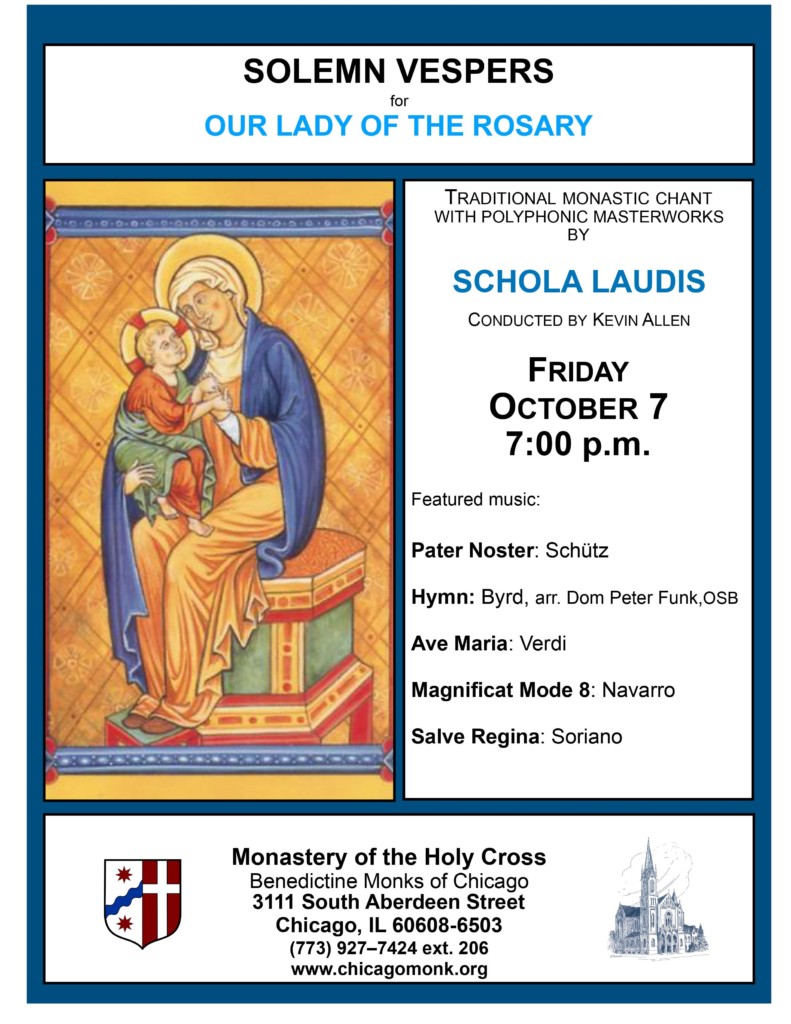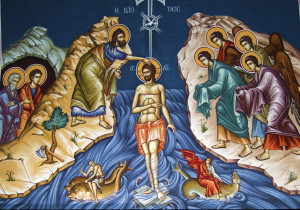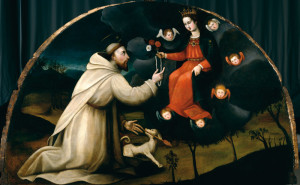My mother taught me to pray the rosary. In her family, they had the old custom of praying a decade nightly on their knees, with my grandfather leading the prayer. While that lovely custom didn’t continue into my generation, the rosary continued to be the primary mode of prayer. It was definitely what we turned to when life became anxious for any reason.
The rosary developed over many centuries and through many twists and turns. The pious legend that Our Lady gave it directly to Saint Dominic has helped to cement the connection between the “Domini Canes” (the “hounds of the Lord” as the Dominicans have been playfully nicknamed) and Our Lady as the Vanquisher of All Heresies. The deep history is in the lay spirituality of the high medieval period, when lay brothers in monastic communities used beads to count 150 Paternosters in place of the 150 Psalms that were required weekly of the choir monks (who could read, and thus were expected to digest these extensive texts).
Eventually, these 150 beads came to represent 150 Ave Marias, and these were further divided into 15 decades, to which were assigned the familiar Joyful, Sorrowful, and Glorious Mysteries. Connecting the prayers to the Mysteries seems to have been another monastic innovation, this time from the Carthusian Dominic of Prussia. Confraternities of the rosary became popular in the late 15th and early 16th centuries.
But it was the clash of civilizations that culminated in the great Battle of Lepanto on October 7, 1571 that cemented today’s feast into the liturgy. As the Ottoman fleet prepared to square off against the Holy League of Catholic states, led by the soon-to-be famous Don John of Austria, Pope Saint Pius V urged all Catholics to pray the rosary in defense of Christendom, already tottering in the wake of the Reformation. The League’s decisive victory was attributed to Our Lady’s intercession, and effectively ended the Ottoman threat for another century and a half.
While the contemplative dimension has never been absent from the rosary, this more “militant” aspect also became more typical of the devotion. It is a part of spiritual warfare, as I discovered as a child, learning to ask Our Lady fervently for her protection under duress. The addition of the Fatima Prayer (…Lead all souls into heaven, especially those most in need of Thy mercy) strengthened the sense of prayer as battle. Pope Leo XIII, in his 1883 encyclical Supremi Apostolatus Officio, urged Catholics again to take up the rosary in battle, this time a more clearly spiritual battle than at Lepanto, against the incursions of particular evils into modern society.
More recently, Pope Saint John Paul II wrote his own apostolic letter, Rosarium Virginis Mariae, in which he extolled the contemplative dimensions of this devotion, even adding five new Luminous Mysteries. While I have heard some criticism of these additions (they disrupt the parallel between the 150 Ave Marias and Psalms), they are very much in line with another important document from his papacy, issued by the Congregation for Divine Worship and the Discipline of the Sacraments. In this directory, pastors were urged to help the faithful to draw the connections between popular lay devotions and the liturgy. The 15 original Mysteries of the rosary corresponded to the most important mysteries of the Liturgical Year. John Paul’s introduction of the Luminous Mysteries fills out the traditional mysteries of Epiphany (adding the Baptism of Jesus and the Wedding at Cana), adds the central feast of the Transfiguration and the solemnity of Corpus Christi, and invites us to meditate on the feasts of the Apostles in the third of the Luminous Mysteries.
We happen to live in a most perplexing moment when, as in the times of Pius V and Leo XIII, the demonic spirit of deceit, division, and violence is visibly attacking the Church and humanity. In 2018, Pope Francis issued his own call to Catholics to engage anew the spiritual battle under the banner of the Virgin Mary, “asking the Holy Mother of God and Saint Michael Archangel to protect the Church from the devil, who always seeks to separate us from God and from each other.” It is not a coincidence that the rosary has recently been in the news, albeit with a certain amount of misinterpretation, as a symbol of (spiritual) militancy.
May our celebration this evening be pleasing to Almighty God, and may the Virgin Mother of God once again crush the head of the Serpent, that we may spend our days in peace and conversion of life. And may Christ lead us all to everlasting life. Amen.

